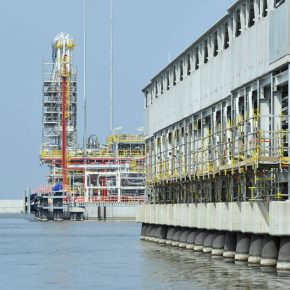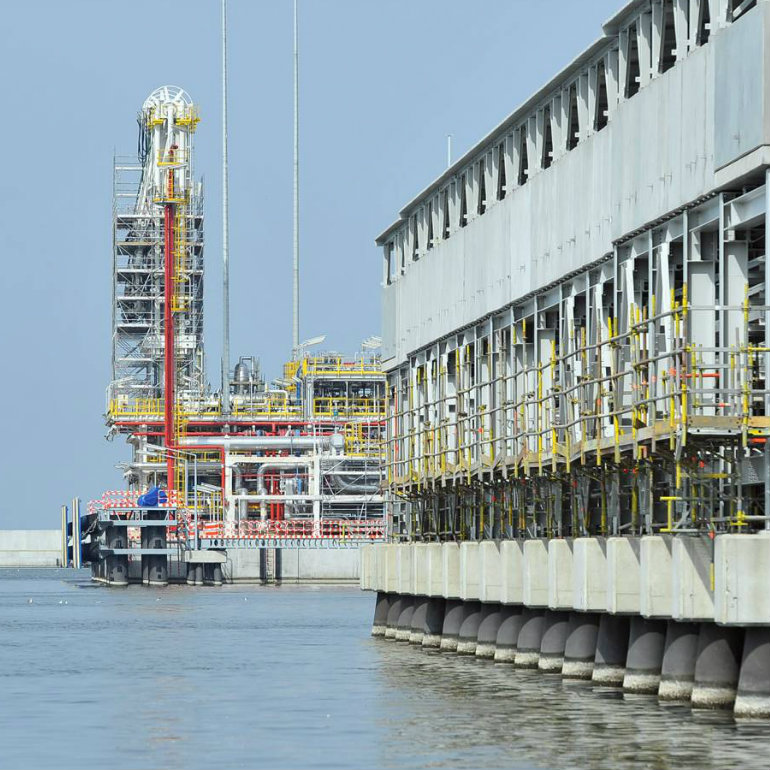Tydzień w gospodarce
Category: Trendy gospodarcze

The LNG terminal in Świnoujście, Poland (©PAP)
Gazprom announced that it reached an agreement with the Slovakian transmission pipeline operator, Eustream, concerning the transmission of gas from NordStream2 through its infrastructure. In response, the Slovakian company issued a short statement, as Wojciech Jakóbik, an energy sector expert, noted on his blog. According to him, Slovaks obtained Gazprom guarantees that the Slovakian and Czech transmission system will continue to be used even if the NordStream2 pipeline is built.
This is another element of the European game around NordStream2, which weakens the Polish position. Guarantees for the Slovaks mean that their support for Poland in the “pipeline war” will slacken. We can assume with high probability that now the Slovaks will not stand firm behind Polish demands to stop the Russian investment (thus approaching the tactics already adopted by the Czechs).
A weaker coalition against Gazprom is a compelling reason to speed up the planned investment projects which will make Poland independent from Gazprom deliveries. “We do not know the details of the Slovak decision as Eustream has not been very specific. One thing is certain, the faster we implement our projects the better,” says Wojciech Jakóbik.
In May, Piotr Naimski, the government’s plenipotentiary for strategic energy infrastructure, announced that Poland was not planning to renew the long-term contract on the delivery of Russian gas due to expire in 2022. Where is Poland going to get its gas from 2022 on, then?
Poland uses 15 billion cubic metres (bcm) of gas annually, 10 bcm of which comes from abroad. As much as 70 per cent of imported gas comes from Russia. Poland has long been declaring the necessity to reduce this dependence.
An important impulse for the intensification of work on the diversification of gas supply sources was the annexation of the Crimea in March 2014. It spurred Polish concerns about stoppage in the flow of Russian gas through Ukrainian pipelines. These concerns were not unwarranted, as in the past Moscow turned off the tap on the pipelines going through the Ukrainian territory several times in order to wrestle various concessions from its western neighbour.
The annexation of the Crimea also constituted a wake-up call for the other EU countries which started wondering whether they were also dependent on Russian supply or whether they could cope without it. The conclusions turned out to be unfavourable for Russia. For example, the CEO of the Italian concern ENI commented that Russian gas constituted only one third of the concern’s consumption and in the case of unforeseen circumstances, supply from this direction could be easily replaced by other sources.
Also Piotr Naimski considers supplies from alternative sources to be fully capable of replacing deliveries from Russia. The key role is assigned to the LNG terminal in Świnoujście which can receive 5 bcm of liquefied gas annually. In June, the first ship with a commercial supply of gas arrived at the terminal. Earlier, at the turn of the year, Al Nuaman ships had arrived to Świnoujście with gas earmarked for the test start-up of the installation.
The terminal offers the possibility of importing gas from the Middle East, the US and Africa. This is the biggest investment of its kind in Central Europe and so far the only possibility of importing this commodity from a different source than Russia. The investment is not over yet. There are already plans to enhance it and increase its operating capacity to 7.5 bcm a year.
The LNG terminal in Świnoujście alone will not be enough, however, to ensure Poland’s energy security. This will require another pillar, and Poland wants gas imports from Norway to play that role. A pipeline from Norway to Poland is not a novel idea. It was brought up already by Jerzy Buzek’s government and the originator of the project was no other than Piotr Naimski, security advisor to the Prime Minister at the time. No wonder that he wants to come back to this concept now.
An ideal variant would consist in effectuating the deliveries through Denmark. Following President Andrzej Duda’s visit to Copenhagen, assurances were made that all the three interested parties were working on the project. There is no indication, however, when we can expect the results.
It is a good moment to encourage Denmark to cooperate. This country has to decide promptly where to obtain its gas in the future, since 90 per cent of its demand is met by production from the Tyra gas field, due to run out in two years’ time. Denmark may seek new deposits or strengthen its connection with Germany, but it can also import gas from Norway, and this is the variant Poland would hope for.
The Danish look with interest at the Polish proposal of a submarine pipeline. It could link the transfer systems of Denmark and Poland, and could have Norwegian gas flowing in it. The Baltic Pipeline is congruent with the concept of North-South corridor and Baltic Energy Market Interconnection Plan which are considered EU priorities in the development of energy infrastructure.
Piotr Naimski announced that an agreement leading to the investment decision on the construction of a connection between Polish territory and gas fields on the Norwegian shelf was going to be concluded by the end of this year. The carrying out of the project would take three to four years. This means that from 2022 the whole system should already be fully functional.
Piotr Naimski’s statement should not be construed as announcing the renouncement of Russian gas altogether. It was meant specifically to call into question the sense of concluding a long-term agreement which does not preclude further cooperation on new, more favourable conditions from the Polish point of view. The arrival of new gas providers onto the market forced Gazprom to offer its customers more flexible conditions. There is no reason why Poland should keep paying one of the highest fees among the European customers, and in the “take or pay” formula on top of that.
Even Russian experts in the gas market concede that in the nearest future we will see a decreasing role of long-term contracts. Asked for his opinion about Gazprom’s take on the issue, Aleksiey Kalatchev, Finam investment company analyst, admitted that the Russian concern was moving away from these instruments.
“I think that the trend of moving away from bilateral long-term contracts is going to last. It also coincides with the draft directive by the European Commission, which assumes that long-term contracts on gas deliveries from third countries will first have to obtain Commission approval,” explained Aleksiey Kalatchev.
A good example of Gazprom opening up to new market challenges is provided by auction sales of gas. The first an auction took place in September 2015. More than 40 deals were made with 15 counterparties. More than 1 bcm of gas, i.e. one-third of the volume offered, was sold in total.
In March 2016, the first auction for the Baltic Republics took place. From the 560 million cubic metres, 420 million were sold, which was greeted by Gazprom as an outstanding success. Following up on this, it announced the organization of new auctions all over Europe.
If Gazprom can be flexible vis-à-vis its customers in Western Europe, it should also put forward a new offer to the Polish Oil and Gas Company PGNiG. Otherwise, it might not be seriously taken into consideration by the Poles anymore.
Another separate issue at play here is that no-one is able to predict what the gas market will look like in six years’ time. Asked about the incentives which Gazprom may offer to Poland in 2022, Aleksiey Kalatchev noted that it cannot be ruled out that prices offered in long-term contracts will be better than those on the spot market. “Polish customers will make up their minds and come to their own conclusions,” the analyst says.
Asked about Gazprom’s reaction if countries start moving away one after another from negotiating long-term contracts, the analyst admitted that, paradoxically, moving away from long-term contracts may turn out to the advantage of the company. In the face of low prices and little prospect of price hikes, the commitment to provide gas for 10 years or longer could entail huge losses. In his opinion, Gazprom will concentrate on other selling methods in the near future (e.g. through auctions).
The increase in the share of LNG in the total gas exports is due, among other factors, to ever better transport and storage infrastructure. Agata Łoskot-Strachota from the Centre for Eastern Studies (OSW) writes about two waves of increase in its availability.
The first one took place in 2009-2010, when new terminals increased the existing exports capacity by ca. 100 bcm. “The first wave of LNG contributed to the liberalization of the European gas market and to the increase in the role of auctions and spot prices. There was a short-lived rise in the share of LNG in the structure of European gas imports but no lasting changes in the sources of gas supply on the scale of the entire EU,” she said.
The second wave started in 2015 and heralds a continued increase in the popularity of LNG. By 2020, LNG exports all over the world are expected to rise by another 40 per cent. There are more than 100 LNG terminals in the world. Most of them in Japan.
23 are in Europe, with Spain claiming the highest number as a single country. Of course, the real level of exports will depend on various factors, e.g. global gas prices. If the prices are low, some exporters may withhold sales for a while.
Agata Łoskot-Strachota also points to the fact that trading practices related to LNG exports are changing, particularly with respect to Australian and US gas. “The US commodity is not indexed to oil but to gas prices on the US Henry HUB Exchange, and there are no geographic restrictions written into the contracts. This allows gas to be sold almost all over the world depending on the conditions on the market, particular needs and capabilities. Different rules for sales from those previously applied, adopted in LNG trade from US practices seem to offer bigger flexibility and the possibility of reacting to changing conditions. This quality may encourage their spreading use,” she wrote in her study.
These changes strongly affect Gazprom’s standing. There are already two countries in CEE region – Poland and Lithuania, which own LNG terminals with a joint processing capacity of 7 bcm of gas a year. The starting up of a floating terminal (with a symbolic name “Independence”) at the shores of Klaipeda in 2014 put Lithuania in a privileged position vis-à-vis Gazprom. Although Lithuania had long been unable to make any impression with repeated pleas for lower prices, once it opened the terminal, it suddenly found the Russian side much more pliable.
In this situation Poland, which is a larger customer, should also play tough and make use of the fact that the gas market is becoming a customer’s market not a vendor’s market as before.
Polish authorities hope that the LNG terminal and gas connection with Norway will contribute to the creation of a gas hub in Poland supplying other countries of the region as well. “We would like the gas coming to Poland from the north to be offered and transmitted through the Polish system to other countries to our south, so that those Central European countries which have been largely dependent on one provider have a possibility of choice,” said Piotr Naimski at the conference devoted to the LNG market. Until now, the interest in obtaining gas from the LNG terminal has been expressed by Hungary, but Piotr Woźniak, CEO of PGNiG (a Polish state-controlled oil and natural gas company), points to the Czech Republic and Bulgaria as potential recipients.
Advanced preparations have also been made for the construction of a gas interconnector between Ukraine and Poland. It will enable the transport of gas from the LNG terminal in Świnoujście to Ukraine. The project is being implemented by Gaz-System in Poland and Ukrtranshaz in Ukraine. The pipeline is going to be almost 100 km long and is expected to become operational in 2020. The interconnector will be capable of supplying 10 bcm of gas to Ukraine annually.



